- More to Explore
- Series & Movies
Published Jul 27, 2022

Everything You Need to Know About the Borg Queen
Long live the Queen!
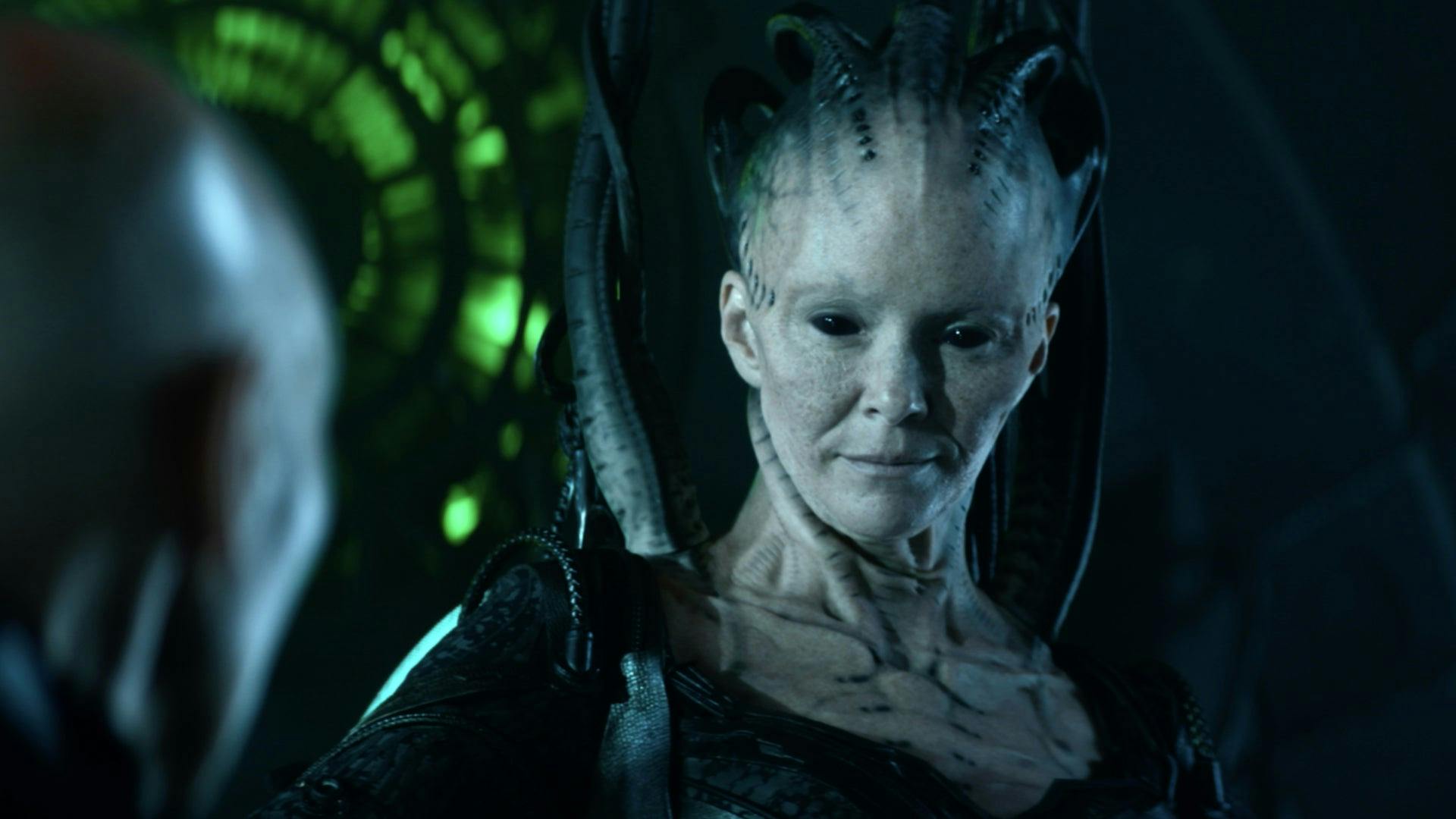
StarTrek.com
“I am the beginning, the end, the one who is many. I am the Borg.”
The central locus of the Borg Collective is the amoral Borg Queen . Through her, like the queen of an insect colony, the Hive mind is granted order and common direction.
As the Villain Showdown enter its fourth week, pitting the Borg Queen against Gul Dukat , we’ve put together this handy guide on everything you need to know about the Queen.
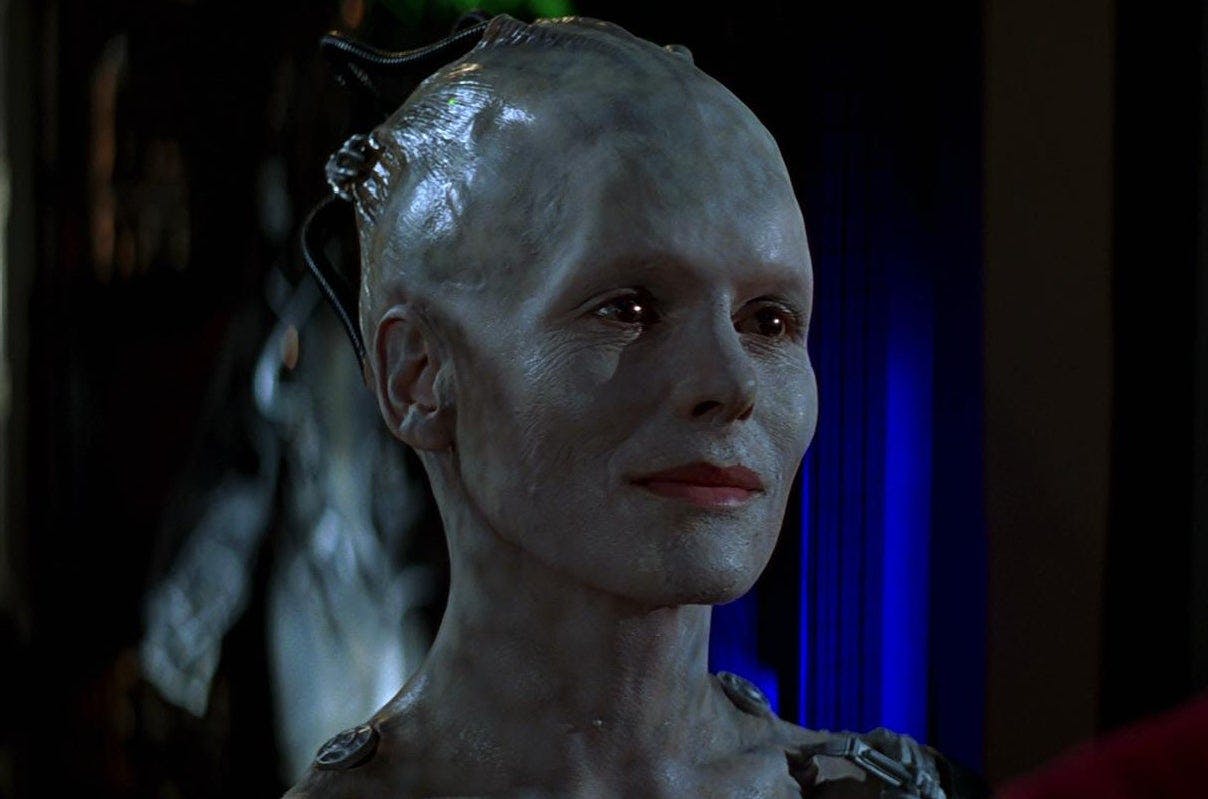
The One Who is Many
Throughout the history of the Borg Collective, there have been a number of Queens. Only one Queen exists at any given time; when she is destroyed, a new Queen takes her place. In Star Trek: Voyager, it's revealed that the Borg Queen isn't a singular entity, but the name given to any that serves as its host, possessing all previous Queen's collective consciousness.
The Borg , a fusion of organic and synthetic matter, and their relentless pursuit of perfection brought fear to all quadrants of the galaxy. Residing primarily at Unimatrix One in the Delta Quadrant , the Borg Queen is the only one able to think independently from the Collective; possessing a unique personality and sense of individuality — traits not seen within the Borg.
The first Borg Queen (Alice Krige) made her debut with Star Trek: First Contact (1996) as the Borg sought to erase a historical moment in Starfleet history— First Contact Day —traveling back in time to prevent the creation and need of the Federation .
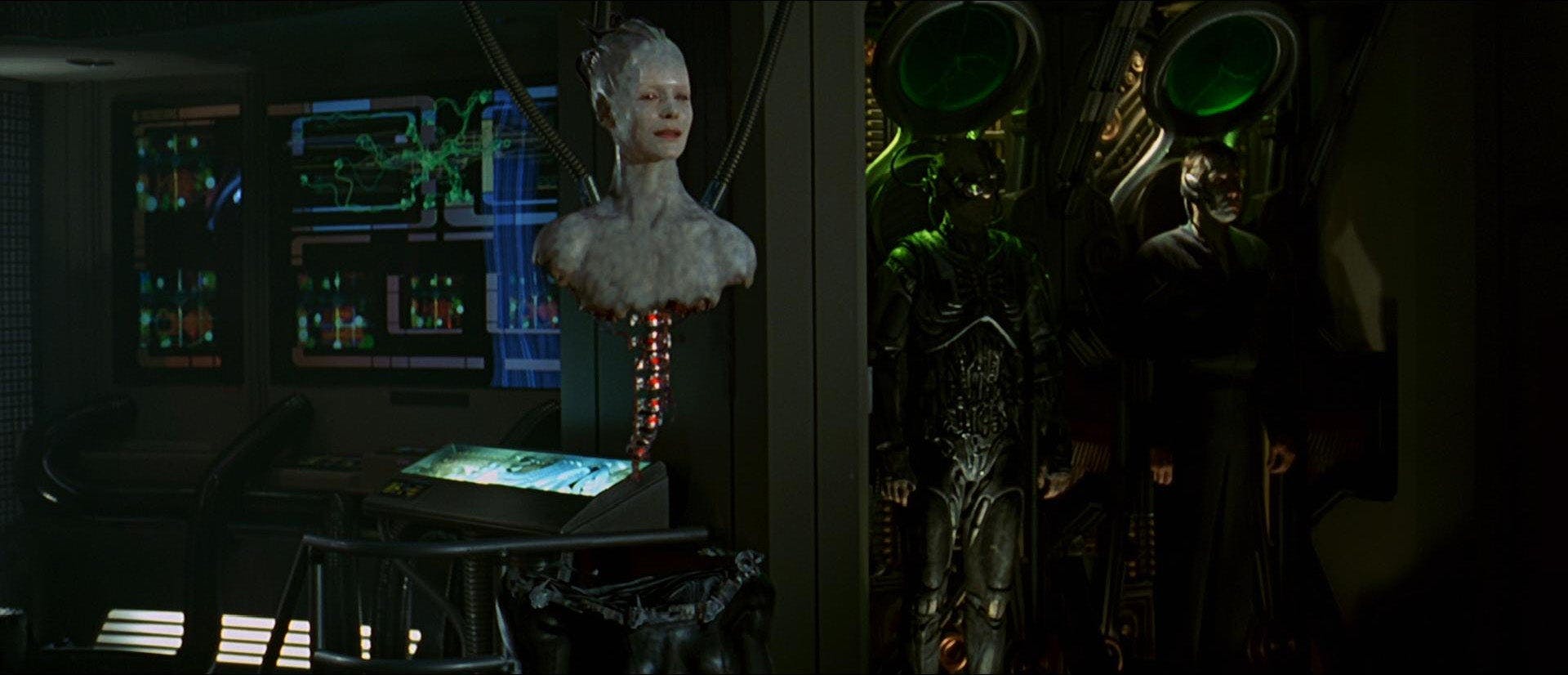
In her lair, the Borg Queen remains disembodied with just her head and spinal column — the epitome of perfection — with no remnants of her humanoid form. When she leaves her home base for assimilation efforts, she will reassemble herself into a predominantly artificial body.
Your Culture Will Adapt to Service Us.
The Borg doesn’t value the Federation’s belief in individuality – its mission is to add others’ biological and technological distinctiveness to their own, strengthening the Collective in its pursuit of perfection. Defeating their opponents isn’t enough; they sought to assimilate their enemies’ minds and flesh.
Captain Jean-Luc Picard still endures residual trauma decades later following his assimilation into the Borg . As Locutus of the Borg, selected to be their voice to facilitate their introduction into human society, Picard believed he never fully regained himself after they striped away his humanity and sense of self.
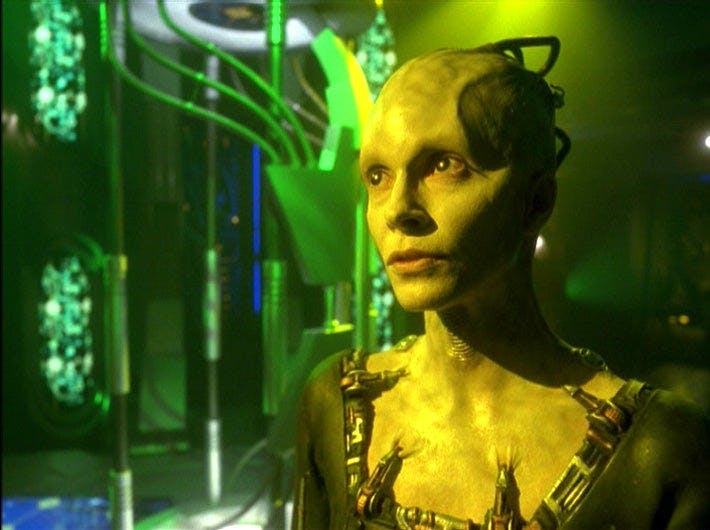
There is No 'Me,' Only 'Us'
It is in Star Trek: Voyager where we learn that the Borg Queen, obsessed with power, didn’t create the Borg; she was just tasked with leading the Collective. The collective consciousness, where each drone is linked through the subspace network, allows for the Borg to adapt quickly and eliminate threats as they arise.
In the episode " Dark Frontier " of Star Trek: Voyager, the Borg Queen believes Seven of Nine 's presence is vital to their path forward in their approach to assimilate Earth, seeing value in Seven's knowledge of humanity. The Borg Queen tries to lure her back to the Collective by "allowing" her to remain an individual instead of reverting to a drone. The Queen's seduction involved telling Seven she's "unique," and her experience will add to their perfection. However, she can't be selfish and only think of just her individual self.
Resistance is Futile.
When a Borg Queen is destroyed, another Queen is propped up. Susanna Thompson portrays the Borg Queen in Star Trek: Voyager ’s two-parter, “ Dark Frontier ” and “ Unimatrix Zero .”
Most recently, the Borg Queen was played by Annie Wersching in Season 2 of Star Trek: Picard .
Secrets of the Borg Queen, The
Bringing Order to Chaos
In Star Trek: Picard , the Borg Queen is cut off from the Borg Collective due the actions of Q and a divergence in time. As a result, she becomes wholly and fully obsessed with Agnes Jurati.
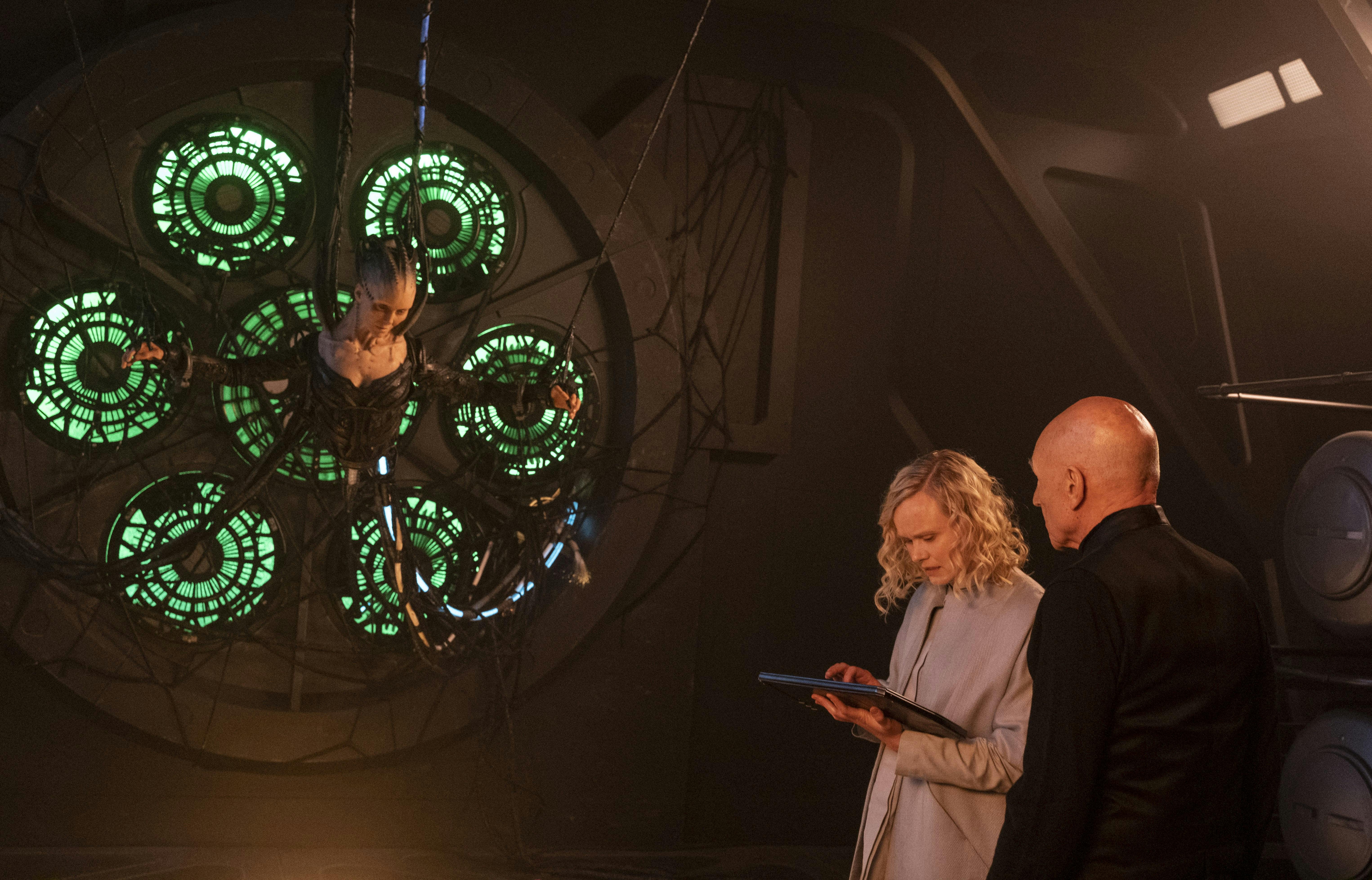
Seen as the last of the Borg, instead of finding the Collective, she sets her sights on Agnes in hopes of building out a new Borg collective.
Star Trek: Picard - The Borg Queen Returns
Interested in learning more about the Borg Queen and her latest machinations, stream all episodes of Season 2 of Star Trek: Picard now!
Christine Dinh (she/her) is the managing editor for StarTrek.com. She’s traded the Multiverse for helming this Federation Starship.
Star Trek: Picard streams exclusively on Paramount+ in the U.S. and is distributed concurrently by Paramount Global Distribution Group on Amazon Prime Video in more than 200 countries and territories. In Canada, it airs on Bell Media’s CTV Sci-Fi Channel and streams on Crave.
Stay tuned to StarTrek.com for more details! And be sure to follow @StarTrek on Facebook , Twitter , and Instagram .
Get Updates By Email
Everything We Know About the Borg Queen After 'Star Trek: Picard' Season 2
Now that 'Star Trek: Picard' Season 2 has come to a close, let's unpack everything we know about the long-lost Borg Queen.
Star Trek: Picard has ended its strong, focused second season, having tossed the principal characters first into a dark alternate timeline and then several centuries into the past, all thanks to Jean-Luc Picard’s ( Patrick Stewart ) trickster-god nemesis, Q ( John DeLancie ). The major Season 1 characters returned: Captain Rios ( Santiago Cabrera ) now commands a new version of Picard’s old ship the Stargazer ; Raffi ( Michelle Hurd ) and Elnor ( Evan Evagora ) now serve together on a new Excelsior , and Seven of Nine is once again a Fenris Ranger and caretaker of Rios’ beloved La Sirena .
Dr. Agnes Jurati ( Alison Pill ) is another returning character, and for most of this second season, it seemed like the show did not know what to do with her . Then, at about the halfway mark, Jurati’s fate intertwines with one other character, who Star Trek fans haven’t seen in a long time: the Borg Queen ( Annie Wersching ). So who is the Borg Queen? Let’s take a look at her legacy and her current incarnation.
RELATED: How 'Star Trek: Picard' Squandered the Potential of Its New Characters
The One Who Is Many
1997’s Star Trek: First Contact establishes several updates to the Borg which carried over into later series, including Picard. They have the ability to assimilate via retractable cybernetic tentacles, and while we knew they were a decentralized collective, First Contact reveals the singular entity controlling this collective: the Borg Queen, played in that film by Alice Krige .
Krige would go on to portray the character in several episodes of Star Trek: Voyager , including the series finale. Susanna Thompson stepped in to play the Queen in the crucial "Unimatrix Zero" two-parter, setting up a strange mystery that to date has not been directly addressed. At the end of First Contact , the Queen is killed by Captain Picard, who severs her cybernetic spinal cord after Data ( Brent Spiner ) is able to destroy her organic components. The crew of the Voyager encounter the Borg and the Queen in the Delta Quadrant, and the show does not attempt to explain how the Queen can be alive following the events of First Contact .
The Voyager crew encounter the Borg many times during the show’s run, with the series finale centering around a future Janeway ( Kathryn Mulgrew ), who travels back in time to guide her younger self in battle against the Borg. Future Janeway knows that a Borg transwarp hub can propel the ship back to the Alpha Quadrant, and sacrifices herself to poison the Borg Queen and clear the way for Voyager ’s return.
The Borg Slayer
Fast forward to the second season of Picard , which deposits the admiral and company into a dark alternate timeline. Picard himself is a galactically-feared conqueror of countless alien species, and is set to exterminate yet another: the Borg Queen.
In Season 1 of Picard , former Borg drone and Voyager crew member Seven of Nine accessed a Queencell in the massive, abandoned Borg cube known as the Artifact. The concept of a chamber in each Borg cube which could only be accessed by the Queen was made canon. Seven of Nine then relinked herself to the rest of the collective, taking control of them all and allowing the La Sirena crew chance to escape.
The Season 2 premiere ends with a version of the Borg Queen appearing on the bridge of Rios’s Stargazer. Drawn to yet another massive spatial anomaly, Picard’s presence has been requested by an unknown species looking to formally join the United Federation of Planets. This turns out to be a previously-unknown Borg Queen, and as her massive cybernetic tentacles bury themselves in the Stargazer’s consoles and take over her systems, Picard orders the ship to self-destruct.
Jump ahead to this alternate timeline. As the main characters adjust to their surroundings, we learn that Seven was never assimilated by the Borg here. This Annika Hansen has no implants and is in fact the President of the Federation. She is about to honor Picard with the title “Borg Slayer” as he executes the Borg Queen before presumably the entire galaxy.
Echoing Timelines
The misplaced crew quickly comes together, and they learn that they're path back home runs right through the Borg Queen. In this timeline, Agnes Jurati is a scientist working for the Dark Federation and has access to the Queen, who is held in some kind of storage unit. We learn that the Borg have some kind of extrasensory perception of alternate timelines. This Borg Queen understands that the timeline has shifted, and knows who they all are and what they're doing.
Given Seven's reveal that the Queencells were not necessarily created for any one Borg Queen, the notion of a time-shift-sensitive Queen suggests that the Borg Queen could perhaps split her consciousness into many different avatars at once, allowing her to exist as simultaneous incarnations of herself. This could also explain her ability to inhabit the consciousness of Dr. Agnes Jurati. The Queen infiltrates Jurait's mind and in short order finds herself loose on the streets of L.A. in the early 21st century. The Queen needs a certain amount of elements and endorphins to grow her strength, and soon Jurati and the Queen are locked in a battle for control of Jurati's body.
The Star Gazer
The survival of our main characters depends on an internal debate which Jurati eventually wins. She convinces the Borg Queen that no matter the timeline, the Borg are always eventually defeated, whether by "a lone Borg slayer or United Federation." She convinces the Borg Queen that she and her drones will never able to overcome and achieve the perfection she seeks.
Before the season's ultimate dénouement, we watch Jurati and the Borg Queen find a common ground. Borg Queen Jurati then takes off in La Sirena, theoretically giving the Borg a 400-year head start on assimilating the galaxy. Picard and company wrap up their business in the past, repairing the timeline. With what is presumably the equivalent of his final breath, Q sends everyone save Rios (who elects to stay in the past) back to the bridge of the Stargazer, where all of this started.
Picard orders the bridge crew to stand down, cancels the self-destruct sequence, and waits. Borg Queen Jurati reveals herself, and the entire narrative comes full circle. The Borg now openly offer species the opportunity to assimilate. The Borg's request to join the Federation may not have been a ruse, after all. The finale reveal, Borg Queen Jurati tells Picard that there is a much bigger threat out there, one that will necessitate the Federation and the Borg working together. With the cast of Star Trek: The Next Generation all officially returning for Season 3, we can expect the ramifications of Picard 's continuity-breaking overhaul fo the Borg to become the focal point of the show's third and final season.
Picard’s new Borg Queen explains how she fits into Star Trek canon
There have two Borg Queens before Annie Wersching. Now she’s the third Borg Queen... or maybe the fourth?

Resistance is futile. Or, in the case of the new Borg Queen in at least one timeline of Star Trek: Picard Season 2, resistance is optional.
In the second episode of Season 2, “Penance,” we meet a very different Borg Queen than we’ve ever seen before, and possibly a different one than we met in the first episode. Ahead of the next Borg revelation in Picard , Inverse caught up with the new Queen, Annie Wersching, to get a sense of how her take on the character is brand new.
The first thing to know about Annie Wersching’s Borg Queen is that she’s a different version of the character than the Queen we met in First Contact or Voyager . After Jean-Luc and his allies find themselves in an altered version of their own timeline, the Borg Queen they encounter is imprisoned and scheduled for public execution by the brutal Confederation of Earth.
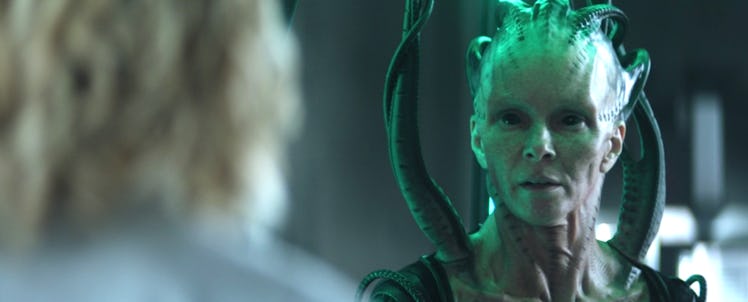
The imprisoned Borg Queen confronting Dr. Jurati.
“We’ve never really seen a Queen not completely in control, ” Wersching says. “She starts in such a strange place of distress. There’s silence in her head and it's maddening. There’s no hive. No Collective. She’s like ‘What the hell is going on?’”
Viewers might have a similar question. In the Season 2 debut of Picard , we met a strange black-robbed Borg Queen with tentacles and a face shrouded by a mechanized hood. We don’t know if that Queen is also played by Wersching, but Dr. Jurati (Alison Pill) makes a point of saying that the Queen’s outfit is “new.” So in Episode 2, when Wersching’s Queen is introduced, Jurati describes her as “more typical,” because she superficially resembles the Queens we’ve met before in First Contact (Alice Krige) and Voyager (Susanna Thompson).
“Of course, after I was cast, I re-watched all the Borg episodes. A lot of TNG. A lot of Voyager, ” Wersching says. “I watched First Contact . But I didn't necessarily watch it all over and over and try to mimic either Susanna or Alice. I just wanted to see what they did, take it in, and then have my own take on it.”

The Borg Queens. Top: Annie Wersching in Star Trek: Picard. Bottom, left-to-right: Susanna Thompson in Star Trek: Voyager , Alice Krige in Star Trek: First Contact , and the mysterious masked Borg Queen in the Picard episode “The Star Gazer.”
Picard’s “Penance” addresses the question of various Borg Queens more directly than any Trek episode before. Seven (Jeri Ryan) and Jurati refer to them as a type of Borg leader, rather than just one person. This is echoed in how Wersching talks about the role too.
Canonically, there have now been different Borg Queens. In this new timeline, the Queen could have begun her life as a different person. And because Wersching was in an episode of Star Trek before , things nearly got very complicated. In the 2002 Enterprise episode “Oasis” she played Liana, a character unwittingly raised by holograms created by her father Ezral, played by the legendary René Auberjonois. To Inverse , she reveals that she and producer Akiva Goldsman briefly considered connecting that continuity.
“Akiva said ‘We could make it that she’s actually Liana, and maybe she actually had been assimilated,’” Wersching says. “We thought about making this whole connection. Obviously, we didn’t go there. But Akiva said, ‘It’s the Star Trek world. We can make anything work.’”
For Wersching, appearing in Picard has brought her acting career full circle. 20 years ago, her brief appearance on Enterprise was her “first television job ever.” Now, just like the Borg Queen, Wersching’s Star Trek experience spans generations. “I was a theater kid before that. I kept asking Scott Bakula and Connor Trinneer to help me if I was doing anything too big. Star Trek was my first big learning experience.”
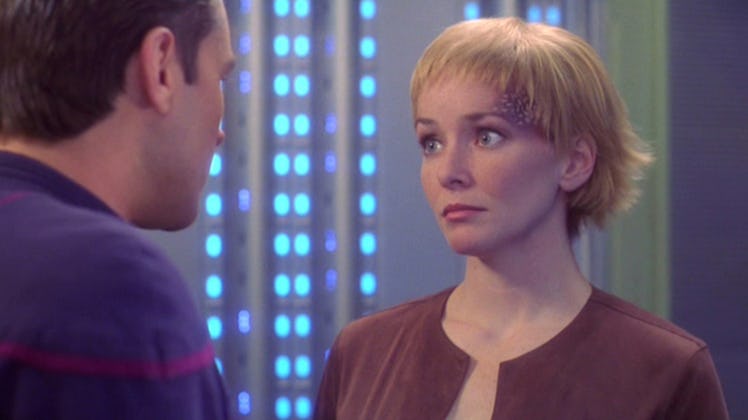
Annie Wersching on Enterprise in 2002.
Wersching teases that there are even bigger surprises coming in Picard Season 2. Specifically, she mentions that her connection with Picard regular Agnes Jurati will play out differently, and more surprisingly, than any other Borg-human relationship before.
“We’ve never seen a Queen obsessed with someone like this before,” Wersching says. “Yes, they’ve been obsessed with Locutus or Seven of Nine. But there’s something about Jurati that is fascinating to the Queen. With most of the humans, [the Queen] is annoyed. But with Jurati, she’s like ‘Wait a minute. maybe I can use you.’ It’s a really weird and interesting relationship that they turn to. I can’t wait for people to see it unfold.”
Star Trek: Picard season 2 airs new episodes on Thursdays on Paramount+.

- Science Fiction
A Complete Timeline of the Borg in Star Trek
The Borg are among Star Trek's most terrifying villains, having assimilated Captain Picard and Seven of Nine, but what is their timeline of events?
Quick Links
The creation of the borg through star trek: enterprise, star trek: the next generation is when starfleet engaged the borg, star trek: voyager traveled through borg space and almost destroyed them, the borg returned in star trek: picard for one last battle.
Throughout the six-decade history of Star Trek , there have been many iconic villains, but perhaps none more so than the Borg. Created by Maurice Hurley, the head writer for Star Trek: The Next Generation Season 2, the Borg began as an organic species looking attain perfection. They achieved this by merging their organic bodies with cybernetic components. Individuality was erased, creating a hivemind culture of beings that sought only to assimilate more species and their technology in the search for perfection. They are led by a queen, a singular consciousness that can occupy multiple bodies.
The Borg are incredibly powerful and are known to travel via transwarp. They are even capable of time travel, though they don't do it very often. Given all that the Borg have going for them, it's no surprise that they were meant to be the ultimate villains Starfleet could never reason with. Over time, these villains became more complex and some even became Federation allies. Yet, the Borg have a long history in the Star Trek timeline, predating the earliest human space travel.
How Did Star Trek: Enterprise Become a TV Series?
The Borg have existed in their modern form since at least the time of the 15th Century on Earth. During the USS Voyager's travels in the Delta Quadrant, they met members of the Vaduwaur species who had been in stasis for more than 900 years. They had "many encounters" with the Borg who, by this time, had assimilated a few star systems in the Delta Quadrant. However, given the Vaduwaur didn't see them as their worst nemesis, they weren't as advanced as the Borg in the 24th Century.
In 2063, a Borg Sphere emerged from a temporal rift to prevent the Humans from making first contact with the Vulcans. The USS Enterprise-E followed them and destroyed the sphere, though a number of drones beamed aboard their vessel. Captain Picard defeated them, and Zefram Cochrane made his first warp flight . Some 90 years later, in Star Trek: Enterprise , remnants of the sphere were found in the North Pole. A handful of drones were revived and escaped in a space vessel. They were pursued and destroyed by the NX-01 Enterprise, but not before sending a message about Earth's location to the collective in the Delta Quadrant.
10 Star Trek Time Travel Stories That Changed Canon
The El-Aurian Guinan was saved by the USS Enterprise-B in 2293, along with fellow survivors of her people. Her planet had been assimilated by the Borg, and this was when Starfleet learned the species' name. Erin and Magnus Hansen, tried to study them in the late 2340s before they and their daughter Annika, Seven of Nine, were assimilated. In The Next Generation Season 2's "Q Who," the omnipotent being sent the USS Enterprise-D thousands of lightyears away from Federation space where it encountered a Borg Cube. They were only concerned about technology at the time, but this meeting led them to Federation space.
One year later, in 2366, the Borg sent a single cube to assimilate Earth. They captured Captain Jean-Luc Picard and assimilated him, giving him the name "Locutus." He was meant to demoralized Starfleet to prevent humans and the rest of the Federation from fighting back. He was freed of their control, but not before the Battle of Wolf 359 which destroyed 39 ships and killed 11,000 people. Among those were the wife of Commander Benjamin Sisko and the crew of the USS Constance of which Captain Liam Shaw was one of ten survivors. Commander Data briefly connected himself to the collective, ordering the Borg drones to enter regeneration and initiating the self-destruct sequence.
In 2368, the USS Enterprise-D encountered the Borg again, discovering a crashed scout ship. The drone Third of Five survived . Picard wanted to use the drone to implant a deadly virus into the collective. However, separated from the collective, the drone became an individual named "Hugh." He was returned unchanged to the collective, though Hugh's individuality caused a meltdown in the collective. A year later, Data's brother Lore found the cube and became their leader. He tried to replace their organic minds with positronic brains like his. The rogue Borg eventually overthrew him with help from the Enterprise. Five years later, another Borg cube was sent to Earth and was eventually destroyed, but not before sending the Sphere holding the Queen back to 2063.
How Did Star Trek: Voyager Become a TV Series?
In 2373, the USS Voyager entered Borg space on their journey home from the Delta Quadrant. At the same time, the Borg tried to assimilate Species 8472, which hailed from a dimension of "fluidic space." The assimilation didn't work and war broke out. Because 8472 was so hostile, Captain Janeway was able to enter into an alliance with the Borg to help defeat them, specifically with the help of the ship's holographic Doctor. The Borg betrayed them, which Janeway anticipated. The drone Seven of Nine was freed from the collective and became a member of the crew. Though she wished to rejoin the collective and tried to do so twice, she eventually chose to stay with Voyager .
In 2375, a transporter accident involving the Doctor's mobile emitter (based on 29th Century technology) and Seven of Nine's Borg nanoprobes. A drone was "grown" in the tank and designated One. The Borg tried to assimilate him and he willingly ended his own life. Later that year, the USS Voyager salvaged a transwarp coil from a destroyed Borg vessel. This led the Borg to enact a trap meant to bring Seven of Nine back into the collective as a replacement for Locutus. Janeway and the crew rescued her. A year later, while trading with the Brunali, Voyager was attacked by Borg vessel. However, they hid a photon torpedo in a captured Brunali vessel that destroyed the Borg ship, allowing Voyager to escape.
In 2377, Seven of Nine was reunited with other Borg in "Unimatrix Zero," a digital plane where drones retained their individuality. Captain Janeway used this opportunity to plan an attack on the collective and start a resistance movement. Captured by the Borg, many of Voyager's crew were assimilated. Thanks to the Doctor, they retained their individuality freeing thousands of drones and starting a Borg civil war. In 2378, a time-traveling Admiral Janeway showed up on Voyager with a plan to get the ship home. The plan succeeded, but the Admiral was assimilated. She carried a virus that decimated the collective to nearly the point of destruction. Five years after the return of the USS Voyager, the rag-tag crew of the USS Protostar found a Borg Cube, but they let sleeping Borg lie .
The Picard Blu-ray Underscores Why Each Season Needed the Borg
A Borg Cube that assimilated a Romulan vessel suffered a submatrix collapse, and it was captured by the Romulan Star Empire. In 2399, the ex-Borg Hugh led the Borg Reclamation Project on a ship dubbed "the Artifact." To stop a plan by a cult of anti-synthetic Romulans in the Tal Shiar, Seven of Nine created her own mini-collective and led the Artifact to crash on a planet populated by synthetics. It's presumed the surviving xBs (as they were called) joined the society on that planet. Hugh, however, was killed in the attempt.
In 2401, a Borg vessel of unknown origin appeared and asked to speak with Admiral Jen-Luc Picard. The Queen of this collective was Agnes Jurati, who was assimilated by the Borg Queen of an alternate timeline who took Picard and his allies into the past to save the future they knew. Jurati convinced the Queen to create a new kind of collective in which individuality was maintained and assimilation was voluntary. This new collective applied for provisional Federation membership to stand guard at a rift in space through which a still-unknown threat would emerge.
Also that year, the near-dying Borg Queen allied with Changeling terrorists angry with the Federation after the Dominion War. They infiltrated Starfleet, adding a DNA sequence to Starfleet transporters that would assimilate anyone under the age of 25 once they received a coded message. That message was sent by Jack Crusher , the son of Picard and Dr. Beverly Crusher. He was assimilated by the dying Borg Queen and named Võx. New technology added to modern Starfleet vessels allowed these new Borg to assimilate the ships in moments. Using a rebuilt USS Enterprise-D, the command crew of that vessel saved Jack and destroyed the remaining Borg, seemingly defeating them once and for all.
The Star Trek universe encompasses multiple series, each offering a unique lens through which to experience the wonders and perils of space travel. Join Captain Kirk and his crew on the Original Series' voyages of discovery, encounter the utopian vision of the Federation in The Next Generation, or delve into the darker corners of galactic politics in Deep Space Nine. No matter your preference, there's a Star Trek adventure waiting to ignite your imagination.
Screen Rant
Why the borg were like that in star trek picard’s finale (it’s explained in voyager).
Star Trek: Picard’s finale saw the return of the dreaded Borg, still reeling from the damage inflicted on them by Janeway in the Voyager finale.
Warning: SPOILERS for Star Trek: Picard Season 3, Episode 10 - "The Last Generation" Star Trek: Picard season 3's series finale "The Last Generation" saw Admiral Jean-Luc Picard (Patrick Stewart) and the crew of the USS Enterprise-D take on the Borg, who were still critically wounded from the events of the Star Trek: Voyager series finale "Endgame." What seemed like a Changeling plot motivated by the fallout from the Dominion War for most of Picard season 3 turned out to be an unlikely team up between the treacherous shape-shifters and the Borg. Through Picard's newly revealed adult son, Jack Crusher (Ed Speleers), the Borg attempted to evolve and continue their conquest of the galaxy.
The last time Picard and friends took on the primary timeline Borg was in Star Trek: First Contact . While Picard was ultimately able to defeat them, the Borg were still considered a lethal threat throughout the galaxy. That changed significantly with the events of Star Trek: Voyager 's final episode "Endgame," which set the stage for Picard's final showdown with his greatest enemy over two decades later.
What Happened To The Borg In Star Trek: Picard Season 3’s Finale
With the revelation that Jack Crusher had been seeded with biological Borg technology through his once-assimilated father, the young man found himself drawn to a voice, similar to the one he'd been hearing in his head his whole life. That voice, of course, turned out to be the Borg Queen (Alice Krige), who lured Jack to a crumbling Borg cube hidden in Jupiter's atmosphere. The Borg Queen, now physically decaying and surrounded by dead and dying drones, utilized Jack's unique biology to infect everyone in Starfleet under the age of 25 with a biological Borg virus, essentially making them organic drones.
After pulling the restored USS Enterprise-D out of the Fleet Museum, Picard and his command crew from Star Trek: The Next Generation head for Jupiter to retrieve Jack and save Earth from destruction at the hands of the assembled fleet. Picard leaves Commodore Geordi La Forge (LeVar Burton) in command of the Enterprise-D while he boards the Borg cube to confront the Borg Queen and save Jack. Picard manages to extract Jack from the Queen's influence, and the Enterprise-D destroys the cube with the Queen inside, seemingly ending the Borg threat for good.
What Happened To The Borg In Star Trek: Voyager’s Finale
The Borg's compromised status is touched upon a bit in "The Last Generation," though not in great detail. While the Borg are primarily associated with Picard and Star Trek: The Next Generation , they would become a major presence in the later seasons of Star Trek: Voyager . The personal journey of former Borg drone Seven Of Nine (Jeri Ryan) became a focal point for many of the show's stories in its back half, and of course would eventually become a major part of Star Trek: Picard .
In the Star Trek: Voyager series finale "Endgame," the crew of the titular vessel are forced to travel through a nebula inhabited by trillions of Borg, including the Borg Queen. They find themselves unexpectedly assisted by a future version of Kathryn Janeway (Kate Mulgrew), who has come back in time to help Voyager get home sooner than it did in her timeline. The alternate Janeway infected herself with a neurolytic pathogen and then allowed herself to be assimilated; the pathogen infected the entire Borg collective, dealing them a devastating blow they'd still not recovered from decades later.
Why Didn’t Admiral Janeway Appear In Star Trek: Picard Season 3?
No Star Trek main character has a stronger tie to the Borg than Jean-Luc Picard, but Kathryn Janeway is not far behind. Not only did she deal them a massive setback in "Endgame," her relationship with Seven became one of Voyager 's most enduring aspects. Now a highly decorated Admiral, Janeway was mentioned several times in Star Trek: Picard season 3, but never actually made an appearance.
The reason for Janeway's absence in Star Trek: Picard was explained by showrunner Terry Matalas as a restriction the show had to manage due to her involvement in Star Trek: Prodigy . That series takes place about two decades before Star Trek: Picard , with Admiral Janeway as one of its central figures. There have also been hints and suggestions that there may be other live action plans for Janeway, so it makes sense that Paramount would want to keep her off the table for now.
Physiology [ ]
The physiology of each Borg drone varied according to the species which it was assimilated from. ( Star Trek: First Contact ) Drones were typically humanoid, although the Collective demonstrated a willingness to assimilate non-humanoid lifeforms. ( VOY : " Scorpion ")
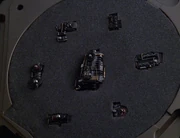
A set of Borg implants after removal
Upon assimilation, a drone would cease to grow body hair and would develop a pallid skin coloration, differing from its original skin pigmentation. Cybernetic implants were either surgically attached to the body or grown internally by nanoprobes injected into the bloodstream; in certain cases these implants could cause severe skin irritation. ( TNG : " The Best of Both Worlds "; Star Trek: First Contact ) The nature of these implants varied from drone to drone depending on the drone's intended function, but the basic nodes of interlink for communications with the Collective and a myo-neural cortical array to control movements were implemented in every drone. In most cases, an eye would be replaced with an eyepiece that improved its vision and an arm would be amputated altogether to make room for a functional prosthetic; in tactical drones, a weapon would be included, and some drones had medical tools built in to heal drones who had minor injuries. ( VOY : " The Gift ", " Dark Frontier ") The implants of a fully assimilated drone allowed it to function for extended periods without shelter, food, water, or even air. A drone could even survive in the vacuum of outer space. Lily Sloane , a human observer local to the Earth of the 21st century , characterized Borg drones as "bionic zombies " after hearing a description of them, albeit before observing them directly. ( Star Trek: First Contact )
A drone's only requirement was a supply of energy to maintain the implants that in turn maintained its biological functions. This energy was supplied during regeneration cycles within a Borg alcove . Upon receiving damage, a drone would return to the alcove for assessment of the damage. Severely damaged drones were disassembled and scavenged for reusable parts. ( TNG : " Q Who ", " I Borg ")
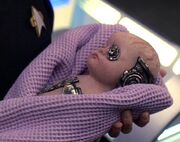
Infant Borg
The Borg did not procreate; they would add to the Collective's population only by assimilation. ( VOY : " Drone ") Borg infants were not accepted to the collective until they matured to a certain age. Until reaching this age, assimilated infants and youths were placed inside maturation chambers . ( TNG : " Q Who "; VOY : " Collective ")
Borg drones were equipped with myriad technologies integrated into their bodies which enabled them to perform their duties within the Collective, several of which were universal to all drones. A neural transceiver kept them connected to the hive mind . ( VOY : " Scorpion, Part II ") A personal force field protected each drone from most energy-based attacks. ( TNG : " Q Who ") A drone was able to communicate with their ship by signals across a subspace domain, the basis of their hive mind, which Data likened to a transporter beam . ( TNG : " The Best of Both Worlds, Part II ") Each drone possessed a pair of assimilation tubules embedded in one hand for the purpose of instantly injecting individuals with Borg nanoprobes. ( Star Trek: First Contact ) A cortical processor allowed a drone to rapidly assimilate visual information. Borg drones were also equipped with a neural processor, which kept a record of every instruction that particular Borg receives from the collective hive mind. Captain Picard used one such processor to discover that the Borg were attempting to use the deflector dish of the USS Enterprise as an interplexing beacon to contact the Borg in 2063. ( Star Trek: First Contact )
Drones also contained fail-safe mechanisms designed to deactivate and even vaporize their own bodies, thereby allowing the Collective to eliminate damaged or dead drones without leaving their remains to be exploited by outsiders. ( TNG : " Q Who ") The captured drone Third of Five also made comments indicating that this vaporization may have been a form of resource re-absorption. ( TNG : " I Borg ") One of these fail-safes was also intended to deactivate drones automatically if they experienced strong emotional states, which the Borg interpreted as a sign of disconnection from the hive mind. ( VOY : " Human Error ")
The Borg typically operated in an atmosphere with a constant temperature of 39.1 °C (102.38 °F ), 92% relative humidity, an atmospheric pressure of approximately 102 kPa , and trace amounts of tetryon particles. According to Amina Ramsey , the Borg smelled like old trash bags . ( LD : " Much Ado About Boimler ").

History [ ]
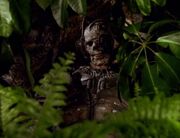
A Borg skeleton on a ruined planet
The precise origins of the Borg were unclear. As of 1484 , they were reported as controlling only a handful of systems in the Delta Quadrant , but by 2373 , they had assimilated thousands of worlds. In addition to this stronghold in the Delta Quadrant, the Borg also dispatched vessels throughout the galaxy via transwarp conduits . ( VOY : " Dragon's Teeth ", " Scorpion ", " Endgame ")
A Borg vessel traveled back in time from 2373 in an unsuccessful attack on Earth in 2063 . ( Star Trek: First Contact ) Drones which survived this defeat were discovered and reactivated by Human scientists in 2153 , and transmitted a subspace message to Borg space before being destroyed by Enterprise NX-01 . ( ENT : " Regeneration ")
The Borg entered the home system of the El-Aurians at some point in their mutual history, swarming through it, scattering its native inhabitants and leaving little to nothing of the El-Aurians in their wake. ( TNG : " Q Who ", " I Borg ") In 2293 , the Federation offered aid to the El-Aurian refugees fleeing the Borg. ( Star Trek Generations ) These refugees included Guinan , who would later provide secondhand knowledge of the Borg invasion of the El-Aurian system to the crew of the USS Enterprise -D during an encounter in the 24th century. ( TNG : " Q Who ", Star Trek Generations ) However, these earlier incidents contributed almost nothing to the Alpha Quadrant 's awareness or understanding of the Borg Collective.
By the 2340s , rumors of an alien race called "The Borg" had reached the Alpha Quadrant, inspiring exobiologists Magnus and Erin Hansen to set out in search of them. Their research took them all the way to the Delta Quadrant, before they and their daughter Annika were assimilated in 2350 . ( VOY : " The Gift ", " The Raven ", " Dark Frontier ") Borg activity in the Alpha Quadrant, including the assimilation of the USS Tombaugh in 2362 and assimilation of outposts along the Romulan Neutral Zone in 2364 , were complete mysteries to Starfleet. ( VOY : " Infinite Regress "; TNG : " The Neutral Zone ")
The Collective's true nature was finally revealed to the Federation in 2365 when Q took the USS Enterprise -D to meet a Borg cube near the J-25 system . ( TNG : " Q Who ")
In late 2366 , a Borg cube invaded Federation space and assimilated Jean-Luc Picard , whose tactical information contributed, along with the Borg's own vastly superior power, to Starfleet 's disastrously one-sided engagement with the cube, the Battle of Wolf 359 . A fleet of forty starships assembled to combat the cube. All but one of these Federation ships were destroyed, while the cube itself remained intact, damaged but healing rapidly. ( TNG : " The Best of Both Worlds ", " The Best of Both Worlds, Part II "; DS9 : " Emissary ") The Enterprise -D recovered Picard and used his connection to the hive-mind to disable the cube before it could attack Earth. ( TNG : " The Best of Both Worlds, Part II ")
During the 2370s , the Borg were beset by several major setbacks in the Delta Quadrant, as witnessed by the crew of the USS Voyager .
The Borg-Species 8472 War decimated the Collective from 2373 - 2374 . ( VOY : " Scorpion ", " Scorpion, Part II ") Voyager 's liberation of Seven of Nine allowed Unimatrix Zero to create an active resistance movement in 2377 . ( VOY : " Unimatrix Zero ", " Unimatrix Zero, Part II ")
In 2378 , a crippling blow was delivered to the Borg when Voyager discovered one of their transwarp hubs and destroyed it, killing the Borg Queen (again) and devastating the Unicomplex in the process. During this battle, the Borg were infected with a neurolytic pathogen , which was carried by an alternate future version of Admiral Janeway and designed to disrupt the hive mind, to 'bring chaos to order'. It was this pathogen that killed the Borg Queen and allowed Voyager to destroy the transwarp hub. ( VOY : " Endgame ") The pathogen decimated the Borg Collective, leaving them reduced a handful of drones slowly cannibalized to sustain the Queen's last remaining body by 2401 . ( PIC : " The Last Generation ")
In 2384 , a Borg cube rendered dormant by the neurolytic pathogen was encountered by the USS Protostar . The crew proceeded to venture into the cube in order to access the vinculum to gain information on how to remove a weapon called the living construct from their ship. When the Medusan Zero volunteered to be assimilated to get the information, this act caused the cube and the drones aboard to wake up. The crew barely managed to escape as they helped Zero to break free from the Collective, who then managed to put the Borg back to sleep. ( PRO : " Let Sleeping Borg Lie ")

The Borg emerge from Jupiter on Frontier Day, 2401
The Borg Collective was still believed to operate as late as 2399 . ( PIC : " Maps and Legends ") On Frontier Day in 2401, this was confirmed after discovery that the main faction of the Borg were working with the rogue Changelings in a plot to assimilate the Federation via a different means than normal. With the Changelings infiltrating the Federation and spreading Picard's Borg-altered DNA through the transporter system, the Borg were able to quickly gain control over 339 starships, and their crews with only those over 25 years old being immune to their takeover. ( PIC : " Võx ") This proved to be the last stand for the original Borg with the Cube, the Queen and all of her remaining drones being destroyed by the rebuilt USS Enterprise -D , presumably bringing an end to the Borg threat. ( PIC : " The Last Generation ")
In the far future , extant Borg assimilated into galactic society, with Borg children learning side-by-side with children of other species. ( LD : " Temporal Edict ")
Alternate timelines [ ]
Confederation of earth [ ].

Borg Singularity in 2401
In 2401 , an atypical Borg Queen reached out to Admiral Jean-Luc Picard seeking membership in the Federation. Much to the Federation's confusion, this Borg Queen was vastly different to the Queen that had been encountered before and her Collective wasn't nearly as outwardly hostile. However, once aboard the USS Stargazer , the Queen began assimilating the ship and through it, the Stargazer's fleet. In response, Picard activated the ship's auto-destruct , stopping the assimilation. ( PIC : " The Star Gazer ")
In that moment, Q had removed Picard, Agnes Jurati, Seven, Raffaela Musiker, Cristóbal Rios, and Elnor from this timeline, and placed them in an alternate 2401. In this timeline, the Borg had been hunted to extinction by the Confederation of Earth , leaving only the Borg Queen . ( PIC : " Penance ")

The Singularity and Federation vessels deflecting the energy burst
After being returned from 2024 to 2401 by Q , Picard deactivates the auto-destruct, having deduced that the strange Borg Queen was actually the Queen from this timeline that had merged with Dr. Agnes Jurati in 2024 and had set out to create a different Collective, one based on mercy and choice. These Borg had sought out the Federation's help to stop an energy wave that threatened countless lives and by combining the shields of the Federation fleet and the Borg ship, the two former mortal enemies were able to stop it. However, the Borg didn't know the source of the energy wave or the massive transwarp conduit that emerged from it, only that it was a threat to everyone. Picard granted the Borg Queen's request to grant the Borg provisional membership in the Federation so that the Borg could be "the Guardian at the Gates" watching out for whatever this new threat was. ( PIC : " Farewell ")
Parallel universes [ ]
Picard's death [ ].
In one alternate quantum reality , Captain Jean-Luc Picard was lost in the Battle of Wolf 359 and William T. Riker succeeded him as the captain of the Enterprise -D with Worf as his first officer . ( TNG : " Parallels ")
Victory over the Federation [ ]
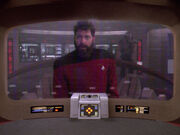
A disheveled Riker of a Borg controlled quantum reality
In another alternate quantum reality, the Borg, after emerging victorious at Wolf 359, successfully conquered the Federation. A battered Enterprise -D, which was likewise under Riker's command, was one of the few remaining Starfleet ships by 2370 . The Riker from that reality was desperate not to return to his universe once all of the Enterprises began spilling into a single universe from a quantum fissure .
After the present reality's Enterprise -D fired lightly upon the other ship to draw the alternate reality crew's attention away from that crew's attempt to prevent the closing of the fissure, the heavily damaged ship was accidentally destroyed when its shields collapsed and their warp core overloaded , due to having a weakened warp containment field , as Riker presumed, from fighting with the Borg. ( TNG : " Parallels ")
Borg-Earth [ ]

Borg-assimilated Earth
In another alternate timeline, the Borg were successful at preventing First Contact in 2063 and had assimilated the Earth. In 2373 , the assimilated Earth had an atmosphere containing high concentrations of methane , carbon monoxide , and fluorine . It had a population of approximately nine billion Borg drones . ( Star Trek: First Contact )
Culture [ ]

A trio of Borg drones, including one of Klingon origin
The Borg Collective was made up of, at the very least, trillions of humanoids referred to as drones. ( VOY : " Dark Frontier ") Through the use of their cybernetic implants, the Borg interacted by sharing one another's thoughts in a hive mind . Upon assimilation, these trillions of "voices" would overwhelm the drone, stifling individual thought and resistance to the Collective's will. ( TNG : " Family ") To some drones these voices could eventually become a source of comfort, and their absence a source of pain. ( TNG : " I Borg "; VOY : " The Gift ")
Borg philosophy was governed by a primary directive to add the biological and technological distinctiveness of other species to that of the Borg. In this manner, the Collective sought to achieve its definition of perfection; all other pursuits were deemed irrelevant including commerce and trade. Accordingly, Borg drones did not engage in any activities except their duties and regeneration . ( TNG : " Q Who ", " The Best of Both Worlds "; VOY : " Scorpion, Part II ") Individual drones have demonstrated puzzlement at other species' unwillingness to be assimilated, the drones believing in the superiority of their way of life.
Having no regard for individuality, Borg drones were identified with designations rather than names. A drone's designation typically described its position within a group, e.g. " Third of Five ." To identify a drone more specifically, its function could be appended to this designation, for example " Seven of Nine , Tertiary Adjunct of Unimatrix 01 ." In the same manner, the Borg referred to alien species by number rather than by name. ( TNG : " I Borg "; VOY : " Scorpion ")
If a drone was sufficiently injured or otherwise in distress, other drones would offer assistance. ( TNG : " I Borg "; VOY : " Dark Frontier ") However, if a drone was deemed irreparable by the hive-mind, the Borg would deactivate it and redistribute any salvageable components throughout the Collective. ( TNG : " Q Who ")
Borg drones ignored alien species until they demonstrated the potential to be a threat, or to be a suitable candidate for assimilation. This indifference even extended to their attitude to people boarding their vessels; the drones went about their business as long as the intruders did not interfere. When addressing a small number of individuals, drones would simply attempt to assimilate them without comment. Before assimilating a larger population, such as a starship or an entire culture, the Borg would collectively transmit a standard announcement of their purpose and the futility of resistance. ( TNG : " Q Who "; VOY : " Dark Frontier "; Star Trek: First Contact ) Species which the Borg found unremarkable or detrimental would be deemed unworthy of assimilation. As of 2374 , the Borg considered the Kazon beneath their notice, and by 2376 , they only took interest in the Brunali if they detected sufficiently relevant technology. ( VOY : " Mortal Coil ", " Child's Play ")
Even examples of civilizations which had previously been targeted for assimilation could be passed over; while moving to engage the dire threat to the Borg presented by Species 8472 , a group of Borg ships encountered Voyager , but, while one ship did pause momentarily to scan the Federation vessel, the Borg ship and its companion ships quickly moved on without attempting to attack or assimilate the interloper in their space. ( VOY : " Scorpion ")

Representatives of the Collective: Locutus with the Borg Queen
On the rare occasions that the Borg were willing to open any dialogue with individuals, they would choose a single drone to speak for the Collective. Jean-Luc Picard was assimilated and given the name Locutus in the misguided assumption that such a representative would lower the Federation's resistance to assimilation. ( TNG : " The Best of Both Worlds ")
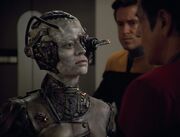
Seven of Nine speaks for the Collective
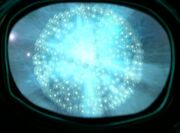
The Omega molecule
When Kathryn Janeway successfully negotiated a truce with the Borg and refused to discuss the terms via a neuro-transceiver , the Collective agreed to communicate via Seven of Nine. ( VOY : " Scorpion, Part II ")
The Borg Queen also spoke for the Collective, acting not as a mere liaison, but as a physical manifestation of the hive mind. The exact nature of her role is unclear. ( Star Trek: First Contact )
The Borg possessed a near-reverence for particle 010 , which they considered to be an expression of perfection. The Collective's fascination with assimilating this molecule has been compared to a religion. ( VOY : " The Omega Directive ")
Tactics [ ]
The Borg had a tendency to "scoop" all machine elements from a planet, leaving great rips in the surface where remaining sections of the road system suggested a city had once been. ( TNG : " The Neutral Zone ", " Q Who "; VOY : " Child's Play ")
The Borg were known to retrieve their own damaged technology, including nonfunctional Borg cubes. However, when a cube underwent submatrix collapse , the collective would immediately sever its link to the afflicted population, considering it dead. ( VOY : " Unity "; PIC : " Maps and Legends ")
Technology [ ]
Borg technology was a combination of technologies assimilated from other cultures, and technology developed within the Collective itself, in order to overcome obstacles to its goals. When confronted by a problem it could not solve with its existing resources and/or configuration, the entire Collective would work in concert to consider all possible solutions, and implement the one determined to be the most efficient. By applying the unique skills of each drone to a task, the hive mind could engineer new technologies and solutions at a pace that would astound an individual. ( TNG : " Q Who ", " The Best of Both Worlds, Part II ")
The Borg were usually exceedingly quick to adapt; their shields would often nullify nearly any energy weapon, and their weapons could usually penetrate nearly any shield or defense, within minutes. ( Star Trek: First Contact )
Spacecraft [ ]
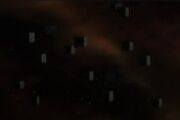
Borg cubes, arguably their most iconic ship design
Borg vessels were highly decentralized, with no distinct bridge , living quarters, or engineering section. Each ship was collectively operated by its complement of drones, under the general direction of the hive mind. Owing to the Collective's disregard for aesthetic considerations, the architecture of Borg ships took the form of basic shapes such as cubes and spheres and were made from a tritanium alloy. Borg ships were capable of regenerating from damage. ( TNG : " Q Who "; VOY : " Endgame ")
Each Borg spacecraft was equipped with a vinculum to interconnect its crew, which was in turn connected to a central plexus that linked the ship to the Collective. ( VOY : " Infinite Regress ", " Unimatrix Zero ") In addition to warp drive , vessels were fitted with transwarp coils that could achieve even greater speed by opening transwarp conduits . ( TNG : " Descent "; VOY : " Dark Frontier ") When critically damaged or otherwise compromised, a Borg ship would self-destruct to prevent outsiders from studying Borg technology. ( TNG : " The Best of Both Worlds, Part II ") In other situations, only the valuable technology would self-destruct, such as the case of the crew of Voyager's first attempt to steal a transwarp coil. USS Voyager encountered several damaged Borg vessels, notably including the cube carrying Icheb , Mezoti , Azan , and Rebi , and a sphere carrying a transwarp coil, which Voyager stole. ( VOY : " Collective ", " Dark Frontier ")
Infrastructure [ ]
Borg structures were located in deep space, in planetary systems, or on planets themselves. Each planet that the Borg modified showed a typical climate and assimilated infrastructure adapted from the previous inhabitants. ( Star Trek: First Contact ; VOY : " Dark Frontier ", " Dragon's Teeth ")
Their buildings consisted of simple shapes, similar to their geometrical ships, and rather than being single structures they were annexed together and added to when needed. By joining the new structures to existing ones, they would form a uniform complex. These buildings were gargantuan in scale, with structures so big that they could house Borg spheres which would dock inside. ( VOY : " Dark Frontier ")
The Borg also constructed structures that had specific functions, such as the transwarp hub . There were six such known hub locations in the galaxy that allowed Borg vessels to deploy rapidly to almost everywhere within it. These transwarp hubs had many structures for opening portals on them, and inside their corridors were interspatial manifolds which supported the transwarp conduits . Several of these manifolds that led to the Alpha quadrant were destroyed by Voyager via transphasic torpedos and collapse of the conduit itself on the vessel's return to the Alpha Quadrant . ( VOY : " Endgame ")
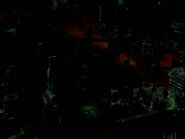
Appendices [ ]
See also [ ].
- Borg Collective
- Borg language
- Borg philosophy
- Borg spatial designations
- Borg species
- Borg species designations
- Borg starships
Appearances [ ]
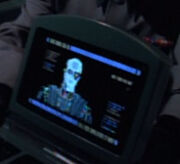
A Borg in the database of Voyager
- " The Best of Both Worlds "
- " The Best of Both Worlds, Part II "
- " Descent "
- " Descent, Part II "
- DS9 : " Emissary "
- Star Trek: First Contact
- " Blood Fever "
- " Scorpion "
- " Scorpion, Part II "
- " The Raven "
- " The Killing Game "
- " Living Witness "
- " Hope and Fear "
- " Infinite Regress "
- " Dark Frontier "
- " Survival Instinct "
- " Tinker Tenor Doctor Spy "
- " Collective "
- " Child's Play "
- " Unimatrix Zero "
- " Unimatrix Zero, Part II "
- " Imperfection "
- " Flesh and Blood "
- " Shattered "
- " Endgame "
- ENT : " Regeneration "
- " Remembrance "
- " Maps and Legends "
- " The Impossible Box "
- " Broken Pieces "
- " The Star Gazer "
- " Penance "
- " Assimilation "
- " Watcher "
- " Fly Me to the Moon "
- " Hide and Seek "
- " Farewell "
- " The Last Generation "
- " Envoys " (holograms)
- " Temporal Edict "
- " Crisis Point " (hologram)
- " I, Excretus " (holograms)
- " wej Duj "
- PRO : " Let Sleeping Borg Lie "
Background information [ ]
Concept and development [ ].
The conceptual genesis of the Borg, who were intended to replace the Ferengi as Star Trek: The Next Generation ' s main villains in its second season, was as a race of insectoids , an idea that would ultimately require modification due to the series' budgetary constraints. As Maurice Hurley explained in the March 1990 issue of Starlog (#152, p. 33): " What we really wanted to do, but couldn't because of money, was create a race of insects...insect mentality is great because it is relentless. The Borg are a variation of an insect mentality. They don't care. They have no mercy, no feelings toward you. They have their own imperative, their own agenda and that's it. If all of them die getting there, they don't care. We needed a villain who could make you dance, and the Borg could do it! "
Hurley made it a plot point in " The Neutral Zone " that Federation and Romulan starbases along the Romulan Neutral Zone had been mysteriously wiped out, having been "scooped off" the face of the planet in the same way that would later be referenced in " Q Who " and shown in " The Best of Both Worlds ". Intentions to lay more extensive groundwork for the Borg's introduction were frustrated by the Writer's Guild strike of 1988 . By the time of their first appearance in "Q Who", the species had been changed from insects to their more budget-friendly cyborg form. ( Captains' Logs: The Unauthorized Complete Trek Voyages , pp. 169 & 180)
The Star Trek Encyclopedia (3rd ed., p. 52) stated: " Writer Maurice Hurley derived the name Borg from the term cyborg (cybernetic organism), although it seems unlikely that a people living on the other side of the galaxy would know of the term. "
According to Michael and Denise Okuda in their Star Trek Chronology (2nd ed., p. 290), there had been plans to connect the parasitic beings from " Conspiracy " to the Borg, but these were ultimately abandoned: " At the time the episode was written, this was apparently intended to lead to the introduction of the Borg in Star Trek: The Next Generation' s second season. The Borg connection was dropped before 'Q Who?' (TNG) was written, and the truth about the parasites remains a mystery. " They also noted that, following production of the latter episode, it was "half jokingly speculated" by Gene Roddenberry that the machine planet encountered by Voyager 6 , leading to its transformation into V'ger , "might have been the Borg homeworld." ( Star Trek Chronology (2nd ed., p. 23))
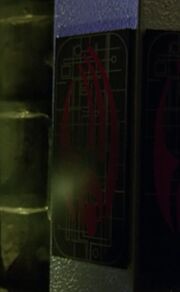
A Borg insignia
The Borg insignia, which first appeared in "Q Who", was described on its own Star Trek: The Next Generation - Inaugural Edition trading card (82-A) as " Resembling a great red claw over a background of circuitry, the symbol of the Borg is as mysterious as the race it represents. The Borg symbol may possibly define an amalgam of living tissue with computer circuits... " [2]
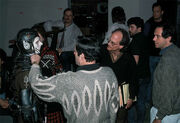
Westmore's Borg make-up is reviewed for "Q Who"
Michael Westmore revealed that the Borg actors were glued into their suits, and had to be unglued if they needed to use the bathroom. [3]
The idea for the sound of the Borg's multiple voices speaking in unison was thought up by sound editor Bill Wistrom and co-producer Merri Howard . After experimenting with different techniques, they discovered a way to lay multiple voices over one another and "make it sound like it was 8 million people," explained Wistrom. ( Star Trek: Communicator issue 147 , p. 32)
Chronologically, the first known in-universe appearance of the Borg to Humanity was in the 1996 motion picture Star Trek: First Contact , in which the Borg traveled back to the year 2063 to enslave the Human race. The writers of the Star Trek: Enterprise episode " Regeneration ", Michael Sussman and Phyllis Strong , stated, in the audio commentary on the ENT Season 2 DVD release, that it was their explicit intent to have the episode deal with the consequences of events depicted in Star Trek: First Contact , the Borg wreckage encountered in that episode being the debris of the Borg sphere destroyed by the Enterprise -E in that movie.
While it is not explicitly stated in "Q Who", Q implies that the sole focus of the Borg is on the technology of the USS Enterprise -D, and the Borg show no interest, in that episode, in the crew (although the segment of hull that the Borg remove from the ship apparently contained several crew members). By their next appearance, "The Best of Both Worlds", the Borg's objectives had changed to the assimilation of lifeforms, and this change of premise was referenced in dialogue. Subsequent episodes ignored the change in premise entirely.
Director Cliff Bole , who directed the "Best of Both Worlds" two-parter, thought highly of the Borg. He enthused, " The Borg are like Klingons. You can do anything you want with them. They're fun and a real expensive thing to play with. With them, you can do a big production value [...] The Borg allow you to have fun with the camera, the lighting and everything else. They challenge the imagination. " ("Cliff Bole – Of Redemption & Unification", The Official Star Trek: The Next Generation Magazine issue 17 , p. 31)
Through the course of Star Trek history, further retroactive continuity changes appear to have been made in respect of the Borg. As of "Q Who" and "The Best of Both Worlds", it appeared that Starfleet had never heard of the Borg. Subsequently, Star Trek: Voyager s " Dark Frontier " and Star Trek: Enterprise s " Regeneration " showed that not only was Starfleet previously aware of the existence of the Borg, Federation scientists actually pursued them – even if they were considered mere rumor. Further, although Guinan indicates in "Q Who" that her people were attacked by the Borg, it is implied that Starfleet was not aware of the threat. However, it was later revealed in Star Trek Generations that Starfleet, in fact, rescued the El-Aurian survivors of the Borg attack including Guinan, and it seems unlikely that Starfleet would not inquire as to the cause of their plight.
The existence of the Borg Queen was a controversial change made to the Borg during the writing of Star Trek: First Contact . While the writers had intended to stay true to the original concept of the Borg as a collective hive, they found it difficult to maintain the dramatic impact of villains without having a central face. Thus, they created the Queen. In the film, she claimed to have been present during the events of " The Best of Both Worlds ", which in retrospect would appear to have negated the reason for Picard's assimilation in that episode (it was claimed that the Borg needed a single representative to speak for them). While the Queen appeared to be killed at the climax of First Contact , she apparently survived unaffected by the Borg's next appearance in Voyager 's " Scorpion ". While many fans have attempted to reconcile this, there has never been an official explanation for her survival (save for an enigmatic comment by the Queen), and the appearance of relatively identical Borg Queens in later episodes. Some, though, have theorized that the Borg Collective contained many queens that served as focal points to different branches of their society. Still another explanation is that the Borg were in possession of innumerable copies of their Borg Queen, and that the superficial death of one version simply resulted in the activation of a similar version to take her place, in a similar fashion to the Vorta . The latter theory was corroborated by Rick Berman in an interview in Star Trek: Communicator . ( Star Trek: Communicator issue 121 )
Impact and legacy [ ]
The Borg were considered as an enemy for the Deep Space 9 crew (along with the Klingons , Cardassians , and the Romulans ) when Star Trek: Deep Space Nine was in development. Rick Berman later commented, " The Borg are not the kind of bad guys that are practical to use on a regular basis. " Whereas the Cardassians were eventually chosen for the main villain role, the Borg made no further appearances in Deep Space Nine after " Emissary ", although they were mentioned in episodes such as " The Storyteller ", " Playing God ", " The Search, Part I ", " The Way of the Warrior ", " For the Cause ", " Let He Who Is Without Sin... ", and " In Purgatory's Shadow ". ( Star Trek - Where No One Has Gone Before ) According to Robert Hewitt Wolfe in a tweet dated 28 January 2019, following the premiere of Star Trek: Voyager , a mandate was passed to the writing staffs of both Deep Space Nine and Voyager that the Borg (along with Q, following his single appearance on Deep Space Nine ) were only to be used on Voyager while Deep Space Nine retained creative control over the Alpha , Beta , and Gamma Quadrants , which Wolfe called "a fair trade." [4]
The Borg were considered by some commentators to be the greatest villains of Star Trek: The Next Generation . However, they were featured in only six episodes throughout its seven-year run. The creators have stated that this was due to the fact that the Borg were so powerful, and so it was not easy to come up with solutions for beating them. However, as time passed and future series went into production, the concept of the Borg evolved to include inherent flaws that could be exploited in many different ways – leading them to appearing in nineteen episodes of Star Trek: Voyager (although in only a fraction of these appearances were the Borg the primary villains; many episodes had them in supporting or otherwise non-antagonistic roles). This generous use caused many fans to complain that the Borg were being used too often on Voyager . TNG, DS9, and one-time VOY writer Ronald D. Moore once said of their perceived overuse, the Borg had been defeated so many times, that they had "lost their teeth." ( citation needed • edit )
Following "Regeneration" and the season it was in, ENT Season 2 , Brannon Braga stated, " We have no plans to see the Borg ever again. " ( Star Trek: Communicator issue 145 , p. 30)
In 2006 , the Borg were honored with their own DVD box set Star Trek: Fan Collective - Borg , featuring a number of their more memorable appearances in the Star Trek universe.
In an interview with StarTrek.com published on 1 April 2019, the actor Alan van Sprang , who played Leland in Star Trek: Discovery , echoed fan speculation regarding a potential connection between Control and the origins of the Borg: "I think it's very intriguing. When I first read the script I thought, 'Oh, is this the making of the Borg? Is that how it happens?' We're as much in the dark as anybody else, but as soon as I saw that, I thought, 'This is like The Borg.' The Next Generation' s Borg episode just blew my mind [when I watched it originally], let alone when Picard became Locutus . That's the first thing I thought of, which kind of tickled me to no end. 'Wow, I'm just going to milk this for all it’s worth.'" [5]
In an interview with TrekCore.com published on 19 April 2019, Michelle Paradise , then writer and co-executive producer of Discovery , clarified: "It's interesting — we weren't thinking Borg at all. I mean, we talked about all sorts of different things in the room, but there was never any intent on our part to parallel that in any way. I can certainly understand why people started to think we were going in that direction, but it was never where we intended to go with it." [6]
In an Instagram story dated 12 March 2020, Michael Chabon , then showrunner of Star Trek: Picard , opined of the same theory: "It has the virtue of making sense. But I don't think it's much fun." [7]
Apocrypha [ ]
The absence of the Borg from Deep Space Nine was explained in the novel The Siege , when a Borg cube tries to pass through the Bajoran wormhole and is destroyed by subspace compression; Sisko concludes that this event will cause the entire Collective to believe that the wormhole is unstable and would now avoid it.
In the alternate timeline seen in the Star Trek: Deep Space Nine book series Millennium , the Borg forged an alliance with the Federation to defeat Weyoun . The entire Borg Collective was destroyed along with the universe. This entire timeline was later reset thanks to Benjamin Sisko.
In an alternate timeline in the game Star Trek: Armada , the Borg succeed in conquering the Alpha Quadrant. Using a clone of Locutus, the Borg manage to assimilate Spock , kill Worf, and assimilate Earth. The timeline was reset thanks to Jean-Luc Picard and the crew of the Enterprise -E, who travel back in time with the aid of a ship from the future to prevent Spock's capture.
In the game Star Trek: Legacy , an alternate explanation was given to the creation of the Borg which states that the probe V'ger created the Collective to serve as its heralds in its search for knowledge. However, the creation of the Borg Queen resulted in the creation of an entity that abandoned the original intent of V'ger . This is also similar to the Shatnerverse version of events.
In the current volumes of the Next Generation Relaunch series of novels, the Borg have been driven to near extinction as a result of the Starship Voyager 's destruction of the Queen and the transwarp conduit network. However, they begin to reconstruct the Collective by building a massive cube in the Alpha Quadrant, in order to launch a vengeful new offensive against the Federation; their first strike results in the assimilation of Admiral Janeway and the destruction of Pluto before the Enterprise -E manages to destroy the cube with the original Doomsday Machine .
In Star Trek: Destiny a history of the Borg was presented. They were survivors of the Caeliar Gestalt and the crew of the Earth ship Columbia NX-02 thrown back in time and into the Delta Quadrant following an attack on a Caeliar city ship. The Caeliar forced the Humans into a perverted form of their Gestalt (a mental linking of the Caeliar) based upon the will of the last surviving Caeliar and not the whole. They launched a final attack of Federation space with over 7,000 cubes at their disposal; however, they were stopped after the Caeliar were made aware of their responsibility for the Borg's actions. The Collective was dismantled, and the assimilated Borg drones were accepted into the Caeliar's gestalt. Former drones fully regained their individuality (as evidenced by Seven of Nine's remaining implants dematerializing). This was followed up in the novel Full Circle . Q later noted that this timeline's invasion was provoked by Admiral Janeway's trip to the past in " Endgame ", reflecting that, if she had done nothing, the Borg would have eventually launched a massive assault on the Milky Way galaxy centuries in the future that would have completely assimilated all other life. The Voyager relaunch novel Unworthy explores the aftermath of the destruction of the Borg, including some Federation scientists trying to harness remaining Borg technology and Voyager encountering a vast fleet called the "Indign" consisting of species who actually wanted to be assimilated but were considered unworthy of that "honor" by the Borg.
In the Star Trek: The Original Series short story "The Trouble with Borg Tribbles" from the anthology book Strange New Worlds V , a Borg cube encountered a pod full of Tribbles which had traveled through a micro-wormhole from the Alpha Quadrant in early 2268 . This was the Borg's first contact with life from that part of the galaxy. The Borg assimilated the surviving Tribbles, only to find that their instinctive drive to eat and procreate was starting to overwhelm the hive mind, causing a widespread series of malfunctions.
The comic book series Star Trek: Countdown shows that Nero 's ship, the Narada , was enhanced with a mixture of Romulan and Borg technology. The sequel miniseries Star Trek: Nero has the Borg, the Narada and V'ger originating from an unknown civilization on the " machine planet " that was seen inside V'ger in Star Trek: The Motion Picture .
The Star Trek: The Manga story "Side Effects" in Shinsei Shinsei provided a different story to the creation of the Borg, with an experiment gone wrong to save a race through the daughter of one of the 1,000 or so survivors. Cybernetic implants, along with DNA from nine different species designed to keep a disease from spreading caused the girl to go insane and gain a twisted idea of saving her people. However, the intervention of Captain James T. Kirk made the situation even worse, as the laboratory where she was augmented collapsed and was sucked into a black hole . But an escape pod with the girl was launched, and apparently catapulted far into the past by the slingshot effect , where her cybernetic implants and DNA evolved to where she became the very first Borg Queen.
In the game Star Trek Online , the Borg have resurfaced after thirty years and have conquered several Federation sectors, including the Mutara sector . The Borg of 2409 look much more like zombies, with some of their cybernetic implants looking like bones coming out of their bodies.
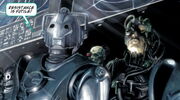
The Cybermen and the Borg
The comic book crossover series Star Trek: The Next Generation - Doctor Who: Assimilation² involves a plotline in which the Cybermen of the Doctor Who universe alter time and space in order to form an alliance with the Borg. The united cyborg force proves to be a devastating threat to the Federation, but the two races end up turning against each other, with the Cybermen going to war with the Borg and forcing the crew of the Enterprise -D and the Eleventh Doctor and his companions to ally with the Borg to restore the Collective and vanquish the Cybermen. At the end of the series, the Borg start to investigate time travel in order to find a way to assimilate the Doctor.
In The Delta Anomaly , a book set in the alternate reality created by the Romulan Nero 's attack on the USS Kelvin , the serial killer known as The Doctor ( β ) is suggested to be related to the Borg. This therefore establishes an earlier contact with Earth than in the prime reality.
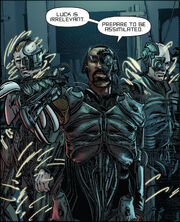
The Borg of the alternate reality
In Star Trek: Boldly Go , a comic series also set in the alternate reality and after the events of Star Trek Beyond , the Borg make an appearance as the villain in the first arc of the series, seeking the Narada due to their awareness of its ties to the Borg. They attempt to assimilate Spock , but the primitive assimilation of this era is unable to cope with his hybrid DNA. The shock of his escape and the retrieval of other near-assimilated officers enables the Federation and the Romulans to destroy the Borg.
External links [ ]
- Borg at Memory Beta , the wiki for licensed Star Trek works
- Borg at Wikipedia
- 3 ISS Enterprise (NCC-1701)
10 Most Satisfying Character-Arcs In Star Trek
1. seven of nine.
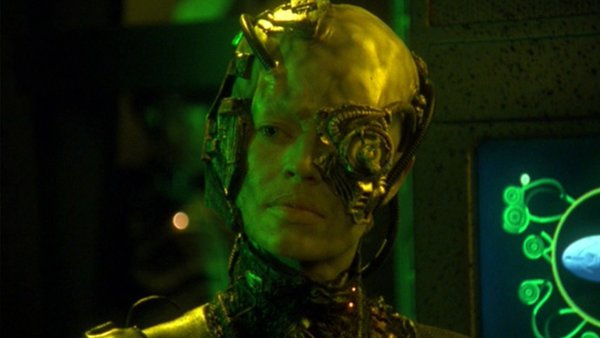
Having been assimilated by the Borg at such a young age, Seven of Nine had a much harder path to reclaiming her individuality than ex-Borg who were only in The Collective for a short time, like Captain Picard.
When Voyager first separated her from The Collective, Seven was openly hostile and tried to summon the Borg to retrieve her and assimilate the whole crew. As she spent more time getting to know other Humans again, she became more comfortable. She was later able to further come to terms with her trauma when Voyager discovered The Raven: the ship she and her parents were taken from when she was a child.
Thanks to her unmatched intelligence and knowledge of Borg technology, Seven became a highly valued member of Voyager's crew. Her achievements included helping to build and manage the astrometrics lab, developing technology for the Delta Flyer, and literally curing death with Borg nanoprobes. When Voyager encountered Borg children, she helped them adjust to life outside of The Collective just as she had done. Still, despite these achievements, when Voyager returned home, Seven was denied formal entrance into Starfleet due to her Borg history.
After this period, Seven became a kind of vigilante for the Fenris Rangers. She had a lot of dark moments during this period, like when she was forced to kill Icheb after having his Borg implants forcibly removed. In Picard' s first season, she briefly became the Borg Queen aboard the Artefact, and in season two she helped correct the timeline and save the future. She was able to prove herself to Starfleet eventually.
She was finally commissioned into Starfleet as a Commander aboard the Titan-A, though she still faced discrimination due to her past as a drone. Still, she proved herself capable once again during the Changeling/Borg incident and ascended to the captaincy of her new ship, now renamed to be Starfleet's new flagship, the Enterprise-G.
Seven has come so far, but it's clear that her story is only just beginning, and we hope to see her and the crew of the Enterprise-G again soon.
Marcia Fry is a writer for WhatCulture and an amateur filmmaker.
Alice Krige
IMDbPro Starmeter Top 5,000 698

- Contact info
- 5 wins & 7 nominations

- The Borg Queen (voice)

- Reno (voice)

- Haruspex Tsimani

- Millicent Hearn

- Andrea Foss

- Borg Queen (voice)

- Veronica Ghent

- Elizabeth Cady Stanton

- Queen Helena

- Nancy Johnson

- Anna Reinach

Personal details
- 5′ 5″ (1.65 m)
- June 28 , 1954
- Upington, South Africa
- Paul Schoolman 1988 - present
- Parents Pat Krige
- Other works She acted in Thomas Otway's play "Venice Preserved" at the Almeida Theatre in London, England with John Woodvine, David Bark-Jones, Ray Fearon, Alphonsia Emmanuel, Richard Mayes, Frank Moorey and John Quayle in the cast. Ian McDiarmid was director.
- 3 Interviews
- 3 Pictorials
- 1 Magazine Cover Photo
Did you know
- Trivia Krige originated the role of the Borg Queen in the film Star Trek: First Contact (1996) , but chose not to reprise her portrayal on Star Trek: Voyager (1995) . Actress Susanna Thompson played the Borg Queen four times on Voyager, but she was unavailable during the filming of the series' final episode (she was not confident into her shooting schedule for Once and Again (1999) ), so Krige resumed the role for the finale.
- Quotes [on people's reaction to the Borg] I became aware, one day on the set, that whenever a Borg moved up to the coffee table, whoever was there would sort of slowly retreat. So the Borg were not only in pain, but they were kind of ostracized. Everyone just uncomfortable in their presence. Which was terribly interesting for me, but I did feel heartbroken for my minions.
- Trademark Deep husky yet smooth voice
- How old is Alice Krige?
- When was Alice Krige born?
- Where was Alice Krige born?
Related news
Contribute to this page.
- Learn more about contributing
More to explore

Add demo reel with IMDbPro

How much have you seen?

Recently viewed

IMAGES
VIDEO
COMMENTS
Admiral Janeway confronts the Borg Queen in 2378. The last encounter between Voyager and the Borg Queen was in 2378. Voyager accidentally discovered a Borg transwarp hub within a nebula and were helped by Admiral Kathryn Janeway, who came from an alternate timeline around twenty-six years in the future, to use the Borg transwarp network to get back to the Alpha Quadrant.
In the episode "Dark Frontier" of Star Trek: Voyager, the Borg Queen believes Seven of Nine's presence is vital to their path forward in their approach to assimilate Earth, seeing value in Seven's knowledge of humanity. The Borg Queen tries to lure her back to the Collective by "allowing" her to remain an individual instead of reverting to a drone.
Alice Krige reprized her role as Borg Queen in Voyager's finale "Endgame", in which she faced off against Starfleet's Admiral Janeway.Physically, this is presumably a different Queen from the one in First Contact and the one in previous Voyager episodes.In order to get Voyager back to the Alpha Quadrant earlier, Janeway traveled back in time to use the Borg's transwarp network.
Susanna Thompson. Actress: Malignant. Susanna Thompson was born on 27 January 1958 in San Diego, California, USA. She is an actress, known for Malignant (2021), Dragonfly (2002) and Once and Again (1999). She is married to Martin B. Katz.
The Borg Queen has appeared in multiple Star Trek projects since Star Trek: First Contact, most notably Star Trek: Voyager and Star Trek: Picard. Voyager helped flesh out the Queen's backstory and added a lot to her lore, while Picard definitively concluded the original Borg Queen's storyline but left the door open for a newer incarnation of ...
Thompson also made one appearance in Star Trek: Deep Space Nine before she became the Borg Queen. In the fourth season episode " Rejoined ," she played Lenara Kahn, the wife of one of Dax's ...
The crew of the Voyager encounter the Borg and the Queen in the Delta Quadrant, and the show does not attempt to explain how the Queen can be alive following the events of First Contact.
This isn't the first time since First Contact that Krige has returned to her famous Star Trek role. When the Borg Queen initially crashed the Voyager party for the episode "Dark Frontier ...
Trekkers met the Borg Queen (Alice Krige) for the first time in Star Trek: First Contact when the Borg attempted to assimilate Earth in 2063, before they were stopped by Captain Picard and the crew of the U.S.S. Enterprise-E. Picard and Data teamed up to kill the Borg Queen but she reappeared on Star Trek: Voyager, albeit with a different ...
Got the role of the "Borg Queen" on Star Trek: Voyager (1995) only because Alice Krige (who played the role in the movie Star Trek: First Contact (1996)) refused to reprise her role.For the final episode, Susanna Thompson was not available (because of shooting Once and Again (1999)) so Alice Krige played the Borg Queen in the final episode.
Dark Frontier: Directed by Cliff Bole, Terry Windell. With Kate Mulgrew, Robert Beltran, Roxann Dawson, Robert Duncan McNeill. Aboard the Delta Flyer, Janeway leads Tuvok, Paris and the Doctor on a rescue mission to retrieve Seven from the Borg Queen. whose treatment of Seven is markedly atypical.
Bottom, left-to-right: Susanna Thompson in Star Trek: Voyager, Alice Krige in Star Trek: First Contact, and the mysterious masked Borg Queen in the Picard episode "The Star Gazer." CBS/Paramount
The Borg Queen is the focal point within the Borg collective consciousness and a unique drone within the Collective, who brings "order to chaos", referring to herself as "we" and "I" interchangeably. ... In one of the few instances of the Borg negotiating, in exchange for safe passage through Borg space, the Voyager crew devises a way to ...
In 2373, the USS Voyager entered Borg space on their journey home from the Delta Quadrant. At the same time, the Borg tried to assimilate Species 8472, which hailed from a dimension of "fluidic space." ... He was assimilated by the dying Borg Queen and named Võx. New technology added to modern Starfleet vessels allowed these new Borg to ...
Here are some of the best stand-offs between Janeway (Kate Mulgrew) and the Borg Queen (Susanna Thompson) in Star Trek: Voyager! Their feud, that spans over ...
The Borg's compromised status is touched upon a bit in "The Last Generation," though not in great detail. While the Borg are primarily associated with Picard and Star Trek: The Next Generation, they would become a major presence in the later seasons of Star Trek: Voyager.The personal journey of former Borg drone Seven Of Nine (Jeri Ryan) became a focal point for many of the show's stories in ...
Alice Maud Krige (Afrikaans: [ˈkriːχə]; born 28 June 1954) is a South African actress and producer. Her big break came in 1981, when she starred as the Gilbert and Sullivan singer Sybil Gordon in the British historical film Chariots of Fire, and as Eva Galli / Alma Mobley in the American supernatural horror film Ghost Story.She received a Laurence Olivier Award for her performance in the ...
Unimatrix Zero Part II: Directed by Michael Vejar. With Kate Mulgrew, Robert Beltran, Roxann Dawson, Robert Duncan McNeill. Although captured, Capt. Janeway squares off with the Borg Queen after successfully introducing the Doctor's pathogen to the Borg Central Plexus. Supply the cure or watch thousands die.
The Borg were a pseudo-species of cybernetic humanoids, or cyborgs, from the Delta Quadrant known as drones, which formed the entire population of the Borg Collective. Their ultimate goal was the attainment of 'perfection' through the forcible assimilation of diverse sentient species, technologies, and knowledge which would be added and absorbed into the hive mind. As a result, the Borg were ...
As the Borg Queen tells Picard, Janeway's infection cut off the hive, leaving her in silence. ... Voyager. The Borg in Star Trek: Picard Season 2, as showrunner Terry Matalas explained in a tweet ...
In Picard' s first season, she briefly became the Borg Queen aboard the Artefact, and in season two she helped correct the timeline and save the future. She was able to prove herself to Starfleet ...
Alice Krige. Actress: Star Trek: First Contact. Alice Maud Krige was born on June 28, 1954 in Upington, South Africa where her father, Dr. Louis Krige, worked as a young physician. The Kriges later moved to Port Elizabeth where Alice grew up in what she describes as a "very happy family", a family that also included two brothers (both of whom became physicians) and her mother, Pat, a clinical ...